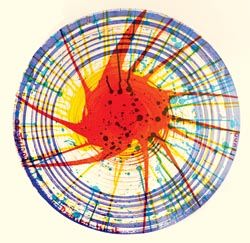Marginal notes
Kyiv’s Bottega Gallery launches an exhibit of works from the British Council collection under the name: Rock, Scissors, and Paper
Rock, Scissors, and Paper is a selection of graphical works by renowned British sculptors from the British Council’s collection from the 1950s till this day. Some are exhibited for the first time.
Above all, the Bottega exposition is interesting because contemporary British art rarely guests in our galleries, except sometimes at the Pinchuk centre. Rock, Scissors, and Paper is a conceptually wholesome project formed by the chief office of the British Council in London, and has already been on display in Armenia, Georgia, and Azerbaijan.
Everyone who admires contemporary sculpture should have heard at least once the names of Henry Moore, Gilbert and George, Eduardo Paolozzi, Anish Kapoor, Damien Hirst, Liam Gillick, Tracey Emin, Bernard Meadows, William Turnbull, Barry Flanagan, Bruce McLean, Bill Woodrow, Anya Galaccio, David Shrigley, Richard Deacon, Mike Nelson, and Hayley Newman. The works of these artists are on display in museums, and in squares and parks of many capitals around the world. Actually, the exhibit itself is an attempt to look behind the scenes
of creating those monuments: what do those serious ladies and gentlemen draw in their notebooks in leisure time?
Most of them are devoted to their profession. Bernard Meadows’s spectacular Cockerel, which looks like a plastic hieroglyph, written in yellow on black background, is only a sketch for his later bronze sculpture Spring ‘Seasons’ Cock (1956), one of animalistic images that won him recognition.
The famous Henry Moore is represented by lithographs of inclined silhouettes (1976-77), images that remotely resemble human bodies. On his part, not less renowned Anish Kapoor, a Turner Prize winner, erects huge metal and mirror constructions. These can be found in his non-figurative etchings (1995-98), which resemble abstractionist experiments of the 1950s and sometimes model pop-art exercises.
One more 20th-century classic, Eduardo Paolozzi, a pop-artist who erected statues which were both realistic and ironic at the same time. His drawings, however, are hermetic in the manner they are executed: two manlike silhouettes are filled with strange mechanisms, and the coloured etchings of 1967 – War Games Revised and Sun City look like complicated schematic plans of unprecedented dystopias and make you feel like peeping in unknown world.
Among all the artists represented, Gilbert and George are probably the most radical: they consider themselves living sculptures, the basis of their most famous performances. According to their concept, they, like Moore, linked their graphical pieces with their main work: their series of realistic self-portrait postcards (1971) bear, besides everything else, quite literary names (Courage, Shyness, Worldliness, Lost Day, Normal Boredom, Experience, Idiot Ambition), and combine the noted duet’s life as living sculptures with various landscapes in the background.
Bill Woodrow’s black-and-white linocuts are self-sufficient, in his “main” collection the artist constructs assemblages and installations for folklore items. This time he created a surrealist periodical table, where each element is illustrated with a composition seemingly taken from a dream, which includes items, body parts of men, animals or insects.
After all, one may notice that graphical works of all the artists represented (especially when compared with their achievements in sculpture) are still marginal notes, which, however, in some unexpected manner depict the artist’s character. For example, Tracey Emin, who is known for the scandalous frankness of her works, drew in ink a pair of female legs and called the picture, in the self-admiration manner typical of the artist, My Beautiful Legs. Damien Hirst exercised in drawing spirals on a turning sheet. He also sprayed the sheets with paint. The pieces look alike, but are named differently, which is indeed very typical of Hirst. Anya Galaccio, who frequently makes tree trunks and branches the central elements of her installations, is represented by a natural history dandelion, a stencilled print on which dandelions on a green meadow are marked with golden paint. Barry Flanagan who makes supraplastic manlike animals of metal, confined himself to the Loch Ness pastoral landscapes – one may only guess what kind of creature he would mould in bronze to set on this lake’s bank.
Can any conclusions be drawn from this exposition concerning what is happening in the UK’s contemporary art? Probably not. Instead we have a wonderful exhibit of actual graphic pieces, a type of marginal notes, which of course were made by extremely talented hands.






